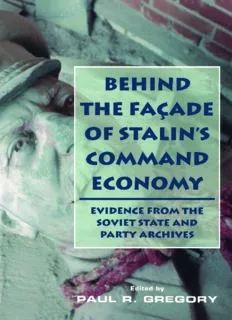
Behind the Façade of Stalin’s Command Economy: Evidence from the Soviet State and Party Archives PDF
Preview Behind the Façade of Stalin’s Command Economy: Evidence from the Soviet State and Party Archives
Behind the FaÇade of Stalin's Command Economy Evidence from the Soviet State and Party Archives Paul R. Gregory EDITOR HOOVER INSTITUTION PRESS STANFORD UNIVERSITY STANFORD, CALIFORNIA .................8732$$ $$FM 03-22-0707:10:15 PS This volume is part of the Richard M. Scaife Initiative on the End of Communism at the Hoover Institution .................8732$$ $$FM 03-22-0707:10:15 PS Behind the FaÇade of Stalin's Command Economy .................8732$$ $$FM 03-22-0707:10:15 PS TheHooverInstitutiononWar, RevolutionandPeace,foundedat StanfordUniversityin1919by HerbertHoover,whowentonto becomethethirty-firstpresidentof theUnitedStates,isaninter- disciplinaryresearchcenterfor advancedstudyondomesticand internationalaffairs.Theviews expressedinitspublications areentirelythoseoftheauthors anddonotnecessarilyreflect theviewsofthestaff,officers, orBoardofOverseersofthe HooverInstitution. www.hoover.org HooverInstitutionPressPublicationNo.493 Copyright(cid:2)2001bytheBoardofTrusteesofthe LelandStanfordJuniorUniversity Allrightsreserved.Nopartofthispublicationmaybe reproduced,storedinaretrievalsystem,ortransmitted inanyformorbyanymeans,electronic,mechanical, photocopying,recording,orotherwise,withoutwritten permissionofthepublisher. Firstprinting2001 ManufacturedintheUnitedStatesofAmerica 06 05 04 03 02 01 9 8 7 6 5 4 3 2 1 Thepaperusedinthispublicationmeetstheminimum requirementsofAmericanNationalStandardfor InformationSciences—PermanenceofPaperforPrinted LibraryMaterials,ANSIZ39.48-1984.(cid:3)(cid:2) LibraryofCongressCataloging-in-PublicationData Behindthefac¸adeofStalin’scommandeconomy: evidencefromtheSovietStateandPartyarchives/ PaulR.Gregory,editor. p. cm. Includesbibliographicalreferencesandindex. ISBN0-8179-2812-X(alk.paper) 1.SovietUnion—Economicpolicy. 2.Soviet Union—History—1925–1953. 3.Stalin,Joseph, 1879–1953. I.Gregory,PaulR. HC335.3.B442001 338.947—dc21 2001024459 .................8732$$ $$FM 03-22-0707:10:16 PS contents Preface vii List of Contributors xi 1 Joseph S. Berliner The Contribution of the Soviet Archives 1 2 Paul R. Gregory The Dictator’s Orders 11 1 E. A. Rees 3 Leaders and Their Institutions 35 R. W. Davies 24 Making Economic Policy 61 Mark Harrison 35 Providing for Defense 81 Oleg Khlevnyuk 46 The Economy of the Gulag 111 Eugenia Belova 57 Economic Crime and Punishment 131 Aleksei Tikhonov and 68 Stalin’s Last Plan 159 Paul R. Gregory 7 Index 193 8 9 10 .................8732$$ CNTS 03-22-0707:10:19 PS .................8732$$ CNTS 03-22-0707:10:19 PS PREFACE The opening of the formerly secret So- viet state and party archives in the early 1990s was an event of profound significance. Western scholars, who previously used Kremlinology to penetrate the official wall of secrecy, could now use the same documents as had Soviet leaders in earlier periods. TheSovietstateandpartyarchiveshavealreadypermittedhistori- ans to rewrite the political history of the USSR. Few deep secrets remain,especiallyconcerningthe1920sand1930s.Economists— relativelatecomerstotheuseofthesearchives—cannowusethem tostudythestillpoorlyunderstoodworkingsoftheStalinistcom- mand economy. Although the Soviet command economy is sup- posedly a thing of the past, it continues to plague Russia’s transition to a market economy, and, more important, it contin- ues to have considerable emotional appeal as a substitute for a marketeconomy.Voicesarealreadybeingraisedclaimingthatthe Sovietcommandeconomywassoundbutitwasrunbythewrong people, who made wrong decisions. The archives give us a real opportunity to examine such propositions. This book summarizes economic research based on the Soviet state and party archives. It brings together prominent scholars fromRussia,theUnitedStates,andtheUnitedKingdom,manyof whom have worked with these archives since they were opened. Topics are discussed in this collection—the economics of the .................8732$$ PREF 03-22-0707:10:22 PS viii Preface Gulag, the management of military innovation, the specifics of defense budgets, Stalin’s handwritten marginal comments on planningdocuments,internalPolitburodiscussions—thecoverage of which could not have been imagined twenty years ago. Each chapter focuses on what we have learned from the archives, on what has surprised us and what has simply confirmed what we already knew. These essays cover the period from the early 1930s through Stalin’s death in 1953, namely, the period of creating the Stalinist system. Since for the postwar era Soviet state and party archives remain basically closed, archive-based research on the ‘‘mature’’ Soviet economy will have to be done by future re- searchers. This publication had its origins in discussions with John Rai- sian, director of the Hoover Institution on War, Revolution and Peace, and with Charles Palm, deputy director, in the summer of 1998 concerning the need to bring to the attention of general readerstheresultsofongoingarchive-basedresearchontheSoviet command system. As the result of a series of agreements with the State Archival Service of Russia beginning in 1992, the Hoover Institution has acquired almost ten thousand microfilm reels of the files of the Soviet Communist Party and state. Because of the deteriorating physical condition of these archives in Russia and the uncertainty of future access, the presence of these archives in Hoover ensures that scholars can mine this treasure of informa- tion over many decades. I am particularly grateful for the support of the Hoover Insti- tution of this project, one product of which is the publication of this book. The chapters by myself, Eugenia Belova, and Aleksei Tikhonov are the products of research conducted in the Hoover Archives and, together with the other chapters of the book, were supported financially by the Hoover Institution through a gener- ous gift of the Lakeside Foundation. I would particularly like to thank John Raisian and Charles Palm for their appreciation of and support of this work. We would also like to thank the dedi- cated staff of the Hoover archives as a whole but would wish to .................8732$$ PREF 03-22-0707:10:22 PS Preface ix singleoutCharlesPalm,ElenaDanielson,andLoraSoroka,with- out whoseassistance this projectcould not have beencarried out. A final word of thanks goes to Patricia Baker, executive editor of the Hoover Press, who sure-handedly navigated this volume to completion in spite of the difficulties of dealing with authors widely dispersed across the globe. Paul R. Gregory References to archival material are given using original notations—fond (f.), opis (op.),delo(d.),andlist(l.)—acceptedinRussianarchives. .................8732$$ PREF 03-22-0707:10:22 PS
Description: